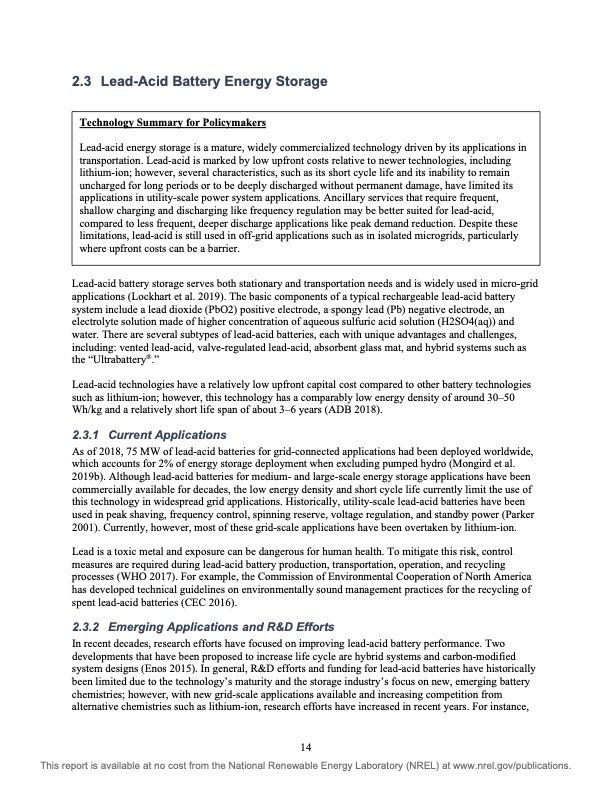
PDF Publication Title:
Text from PDF Page: 021
2.3 Lead-AcidBatteryEnergyStorage Technology Summary for Policymakers Lead-acid energy storage is a mature, widely commercialized technology driven by its applications in transportation. Lead-acid is marked by low upfront costs relative to newer technologies, including lithium-ion; however, several characteristics, such as its short cycle life and its inability to remain uncharged for long periods or to be deeply discharged without permanent damage, have limited its applications in utility-scale power system applications. Ancillary services that require frequent, shallow charging and discharging like frequency regulation may be better suited for lead-acid, compared to less frequent, deeper discharge applications like peak demand reduction. Despite these limitations, lead-acid is still used in off-grid applications such as in isolated microgrids, particularly where upfront costs can be a barrier. Lead-acid battery storage serves both stationary and transportation needs and is widely used in micro-grid applications (Lockhart et al. 2019). The basic components of a typical rechargeable lead-acid battery system include a lead dioxide (PbO2) positive electrode, a spongy lead (Pb) negative electrode, an electrolyte solution made of higher concentration of aqueous sulfuric acid solution (H2SO4(aq)) and water. There are several subtypes of lead-acid batteries, each with unique advantages and challenges, including: vented lead-acid, valve-regulated lead-acid, absorbent glass mat, and hybrid systems such as the “Ultrabattery®.” Lead-acid technologies have a relatively low upfront capital cost compared to other battery technologies such as lithium-ion; however, this technology has a comparably low energy density of around 30–50 Wh/kg and a relatively short life span of about 3–6 years (ADB 2018). 2.3.1 Current Applications As of 2018, 75 MW of lead-acid batteries for grid-connected applications had been deployed worldwide, which accounts for 2% of energy storage deployment when excluding pumped hydro (Mongird et al. 2019b). Although lead-acid batteries for medium- and large-scale energy storage applications have been commercially available for decades, the low energy density and short cycle life currently limit the use of this technology in widespread grid applications. Historically, utility-scale lead-acid batteries have been used in peak shaving, frequency control, spinning reserve, voltage regulation, and standby power (Parker 2001). Currently, however, most of these grid-scale applications have been overtaken by lithium-ion. Lead is a toxic metal and exposure can be dangerous for human health. To mitigate this risk, control measures are required during lead-acid battery production, transportation, operation, and recycling processes (WHO 2017). For example, the Commission of Environmental Cooperation of North America has developed technical guidelines on environmentally sound management practices for the recycling of spent lead-acid batteries (CEC 2016). 2.3.2 Emerging Applications and R&D Efforts In recent decades, research efforts have focused on improving lead-acid battery performance. Two developments that have been proposed to increase life cycle are hybrid systems and carbon-modified system designs (Enos 2015). In general, R&D efforts and funding for lead-acid batteries have historically been limited due to the technology’s maturity and the storage industry’s focus on new, emerging battery chemistries; however, with new grid-scale applications available and increasing competition from alternative chemistries such as lithium-ion, research efforts have increased in recent years. For instance, 14 This report is available at no cost from the National Renewable Energy Laboratory (NREL) at www.nrel.gov/publications.PDF Image | USAID GRID-SCALE ENERGY STORAGE TECHNOLOGIES PRIMER

PDF Search Title:
USAID GRID-SCALE ENERGY STORAGE TECHNOLOGIES PRIMEROriginal File Name Searched:
76097.pdfDIY PDF Search: Google It | Yahoo | Bing
Turbine and System Plans CAD CAM: Special for this month, any plans are $10,000 for complete Cad/Cam blueprints. License is for one build. Try before you buy a production license. More Info
Waste Heat Power Technology: Organic Rankine Cycle uses waste heat to make electricity, shaft horsepower and cooling. More Info
All Turbine and System Products: Infinity Turbine ORD systems, turbine generator sets, build plans and more to use your waste heat from 30C to 100C. More Info
CO2 Phase Change Demonstrator: CO2 goes supercritical at 30 C. This is a experimental platform which you can use to demonstrate phase change with low heat. Includes integration area for small CO2 turbine, static generator, and more. This can also be used for a GTL Gas to Liquids experimental platform. More Info
Introducing the Infinity Turbine Products Infinity Turbine develops and builds systems for making power from waste heat. It also is working on innovative strategies for storing, making, and deploying energy. More Info
Need Strategy? Use our Consulting and analyst services Infinity Turbine LLC is pleased to announce its consulting and analyst services. We have worked in the renewable energy industry as a researcher, developing sales and markets, along with may inventions and innovations. More Info
Made in USA with Global Energy Millennial Web Engine These pages were made with the Global Energy Web PDF Engine using Filemaker (Claris) software.
Sand Battery Sand and Paraffin for TES Thermo Energy Storage More Info
| CONTACT TEL: 608-238-6001 Email: greg@infinityturbine.com | RSS | AMP |